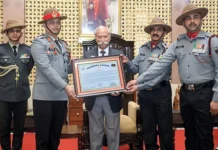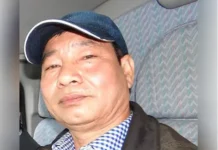[ Lota Singhi ]
Monuments are messengers to the future that carry the heritage of our ancestors. They are like treasures which also act as symbols and pride of a civilization. Monuments have been one of the key factors that helped us understand the level of development of a civilization and the knowledge and thoughts held by its inhabitants.
Unfortunately, there is no tribal monument in the Nyishi belt that is related to the religion, culture, or ethnicity of its people through which we can understand the past. Lack of any remarkable monument in the form of symbol, text, infrastructure, or any other materialistic account is also one of the reasons that our younger generation has lost connection with their own roots.
Most of the young generation have become antagonistic towards their own ancestors, mocking and criticizing them. This is due to lack of understanding and proper guidance. This sort of dishonour invites backlash from some section of the society, creating a line of division which is clearly seen in the society.
Everyone has the right to choose their food, clothes, faith, etc. However, while exercising one’s own rights, he or she shouldn’t make fun of the other and lower their dignity to avoid hostility, because it is the basic right of every citizen to defend their own existence.
Seeing the instability, it was necessary to look around and put some ideas that could put forward the tribal identity, which would be considered a sacred symbol of respect and belongingness. It will tell the past in the future, become a pride and identity, and store the history of its people.
Hence, the people of East Kameng district and the Nyishi community as a whole have decided to build a monument that is purely related to ancient religious and cultural practices. This monument has been named Langrw/Sori Langdi. It will be dedicated to the people of Seppa town and East Kameng as a whole, and to commemorate the auspicious occasion of 50 glorious golden years of Nyokum Yullo.
Langrw/Sori Langdi will be a massive stone pillar obtained from the Kameng river, along with heaps of stones collected from other major rivers which will represent their respective region. Hence the name of the respective rivers will be given to each of the smaller langdis (stones). This Sori Langdi will be built within the vicinity of the Nyokum Lapang of East Kameng district.
As per the customary laws of the Nyishi shamanic chants, the shaman will perform ritual process to sanctify the stone pillar. The consecration formalities will be done during the golden Nyokum period, ie, on 26 February.
The consecration is headed by the shaman of the Golden Nyokum Yullo-2022, along with a few selected renowned priests of East Kameng, and may also invite anyone from each Nyishi district to represent the installation of Langrw/Sori Langdi. The chants of the priest during the ceremonial consecration will be done based on Abotani. The shaman will recite the origin and divine application of stone in the faith. Sori Langdi has many roles in the faith system of the Nyishis since time immemorial. Hence the legacies reign once again through the powerful recitation and consecration of shaman; the spiritual power and judgment; the spiritual and sanctity; the healer and protector; and the justice and soldier.
Character and foundation
The absolute purpose of the Sori Langdi is to become a voice for sustaining the beautiful and unique tribal roots and stand as a symbol of cultural resistance against strange incursion. It will be a centre of cultural talks and a house of mythologies in the days to come. The presence of Sori Langdi from generation to generation will protect the tribal roots from being eroded.
The future is vague. It needs proper and appropriate foundation on both physical presence and the mental dimension to sustain the value and survival of Sori Langdi in the long run.
The massive stone pillar of the Kameng will lead the pride of Sori Langdi, along with numbers of langdis belonging to each of the major rivers, namely, Pochung, Pappu, Pakoti, Pacha, Pachi, Pachuk, Para and the mighty Kameng. It will be like roots to every part of East Kameng, which will play a fundamental role to strengthen the community in all purposes.
It will be an honour to have the sacred stone of the donor river or region for historic establishment of Sori Langdi. The sacred langdis of respective region shall be engaged in wider divine service for the cause of humanity and their culture, which will be known as the saviour of the Nyishi community.
The Nyishi community strongly believes in the power and divinity of stone; hence, gathering of sacred stones from several villages/regions or rivers will not only serve as nerves of the body but it will broaden the value and role of Sori Langdi overseas.
The stories of each of collected langdis will be recorded on the accounts of their own genealogy, divinity and history. The name, origin, colour, weight, size, credentials or other features of the langdis will be recorded in the glittering pages of the divine book called Nyokum Yullo Sori Langdi. It will relay the message of stone divinity and cultural importance of the Nyishi or Abotani. It will be sanctified by an indigenous Nyishi shaman, which is the age-old practice of the community.
Genesis of stone
As per Nyishi mythologies, Maang-Maah and Yaang-Yaah took birth before nothingness. Maang is female and Maah is male. After the birth of Maang and Maah, an offspring called Klo was born. Jwngtar Donyi, the devil sun, is an offspring of Klo. He took birth from the retina of Klo, who came to exterminate the living things.
Similarly, Yaang is referred to female and Yaah is male. They came before soul, colour, or light. They conceived an offspring called Kurum.
Klo gave birth to Nwrma Ney through her teeth. Till the period of Nwrma Ney, the stone genital came into existence; hence she conceived and gave birth to the giant stone called Nrku Ney. During the course of Nwrku Ney, it grinded the giant stone and reshaped it into a proper shape. It is during the period of Nwrku Ney that the last great mother of creation gave birth to many offspring, who were destined to become the following:
Nyangrw Ney-Langrw-Nyangrw Nyangtar became Sori Langdi.
Nyangtung Ney Langtung – she was destined to stand and support water body and soil.
Nyangmo Ney Langmo – Memohney, the devil stone.
Nyangda Ney Langda – destined to become the wall around the earth, such as foundation of the Himalayas.
Nyangbio Ney Langbyo – Mehbioney, the devil stone.
Nyanghi Ney Langhi – smallest stone.
Nyanghr Ney Langhr – stone with pearl-like eyes.
Nyangje Ney Langje – green stone species.
Nyangpung Ney Langpung.
Nyangkya Ney Lang-kya.
Nyanglang Ney Langlang – maroon or red stones that lie on the upper part of earth.
Nyangyam Ney Langyam – this stone is hidden inside another stone and can’t be found until another stone is broken.
Langku Anyari – went to marry Nyangrw Loma, who gave the offspring Loma and Loya. Great father Nyangrw Loma drowned, whose half-buried body was later found by Loma and Loya. Both the sons turned his body into precious stones and metals which we use till today, like laatey, chungre, talo.
Meaning and role
This type of stone has supernatural power and is called Sori Langdi. Many villages of East Kameng district practice such belief since the ancient time. Sori means swearing the truthfulness, and Langdi means the stone pillar that witnesses the swearing. In the olden days, it was used as a swearing or witness on some social resolution like dispute, crime, marriage, etc. It was done after certain recitation by the priest. Some Sori Langdi play a very important role in prophecy and protection of the village and community.
Here, the interpretation of Sori Langdi shall be definitive or forbidden stone. One can’t misbehave with the Sori Langdi. It will be placed in a hygienic and protected place. It is forbidden to touch it casually as it will lose the divinity in the long run. It holds supernatural power, and hence ought to have care and respect. During a natural calamity, the priest shall perform some traditional ritual to convince the deity to protect the human beings. On every Nyokum day, the priest will perform a ritual to enhance the divine power of Sori Langdi. It will guard Seppa town and East Kameng district without any distinction between creeds and castes.
Vision: With the rise of modern complicacies, the tribal culture is on the verge of extinction. There is no documentation and primitive structure that represents the history. In the midst of this crisis, the Sori Langdi will play an important role to uphold the roots and will lead the generation towards the ancestral way.
The day is not far when it will become a strong identity of the Nyishi tribe, a beautiful monument, a significant heritage that propels the essence of being a real Nyishi and their pride. People will start referring to the name and publication related to its existence, which will inflame the beauty and importance of having one’s own roots. Hence, slowly and steadily, it will get into the identity of belonging and everybody will love to call the name. Finally, Sori Langdi will become a sentinel, gloriously shining the name of Seppa.
This Sori Langdi will stand along with a monolith pillar carrying the leaders of Nyokum Yullo celebration for the last fifty years. This small campus will be named ‘Golden Jubilee Nyokum Yullo Memorial Complex’, and will be inaugurate by Chief Minister Pema Khandu in the august presence of several dignitaries. (Concept, research and written by Lota Singhi.)




